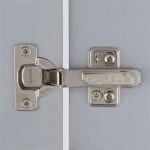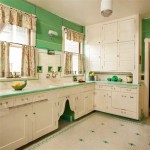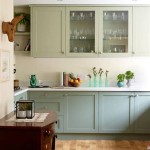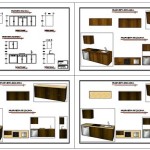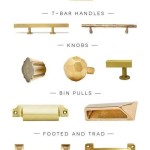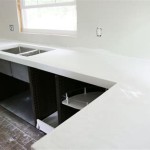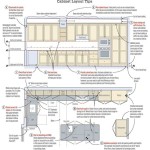The article must be unique. ## Kitchen Cabinet Material Types: A Comprehensive Guide
Selecting the appropriate material for kitchen cabinets is a crucial decision in any kitchen renovation or new construction project. The chosen material significantly impacts the aesthetics, durability, functionality, and overall cost of the kitchen. Understanding the various options available is essential for making an informed choice that aligns with the homeowner's preferences, budget, and lifestyle.
This article provides a detailed overview of common kitchen cabinet material types, outlining their characteristics, advantages, disadvantages, and ideal applications. It aims to equip readers with the knowledge necessary to navigate the complexities of cabinet material selection and create a kitchen that is both beautiful and functional.
Solid Wood
Solid wood cabinets are a classic and highly desirable option, prized for their natural beauty, warmth, and durability. They are constructed entirely from solid wood lumber, typically hardwoods like maple, oak, cherry, and walnut. Solid wood offers a rich, natural grain pattern that can be enhanced with various stains and finishes.
One of the primary advantages of solid wood is its longevity. With proper care and maintenance, solid wood cabinets can last for decades, even generations. They are also relatively easy to repair if damaged, allowing for refinishing, patching, or even replacement of individual components. This repairability contributes to their long-term value.
Solid wood cabinets can be susceptible to changes in humidity and temperature, leading to expansion and contraction. This can cause warping, cracking, or joint separation over time. Proper sealing and climate control are essential to mitigate these issues. Furthermore, solid wood tends to be a more expensive option compared to other cabinet materials.
Different types of wood offer varying levels of hardness, grain patterns, and color variations. Maple is a popular choice for its durability and smooth, consistent grain. Oak is known for its distinctive grain pattern and strength. Cherry offers a rich, reddish-brown hue that deepens with age. Walnut is prized for its luxurious dark color and intricate grain.
Solid wood is best suited for kitchens where a natural, high-end aesthetic is desired and where the homeowner is prepared to invest in proper maintenance and climate control. Its timeless appeal and durability make it a worthwhile investment for those seeking long-lasting quality.
Plywood
Plywood is an engineered wood product made by layering thin sheets of wood veneer, called plies, and bonding them together with adhesive under heat and pressure. The grain direction of each ply is oriented perpendicular to the adjacent layer, which provides exceptional strength and stability. Plywood is a versatile material widely used in cabinet construction, particularly for cabinet boxes and drawers.
Plywood offers several advantages over solid wood. It is less susceptible to warping and cracking due to its layered construction. This dimensional stability makes it a reliable choice for areas with fluctuating humidity levels. Plywood is also generally more affordable than solid wood, making it a cost-effective option for large kitchen projects.
While plywood is durable, it is not as resistant to dents and scratches as solid wood. The edges of plywood require finishing, such as edge banding, to conceal the layered construction and protect against moisture intrusion. The quality of plywood can vary depending on the number of plies, the type of wood veneer used, and the quality of the adhesive.
When selecting plywood for kitchen cabinets, it is important to consider the grade and thickness of the material. Higher grades of plywood have fewer voids and imperfections, resulting in a smoother surface and greater strength. Thicker plywood provides greater structural integrity for cabinet boxes and shelves.
Plywood is a suitable choice for kitchens where durability and stability are paramount, and where cost is a consideration. Its engineered construction provides a reliable and affordable alternative to solid wood, making it a popular choice for both cabinet boxes and drawers.
Medium-Density Fiberboard (MDF)
Medium-density fiberboard (MDF) is another engineered wood product made by breaking down hardwood or softwood residuals into wood fibers, often in a defibrator, combining it with wax and a resin binder, and forming panels by applying high temperature and pressure. MDF is known for its smooth, uniform surface and its ability to be easily shaped and machined.
MDF offers several advantages for kitchen cabinet construction. Its smooth surface is ideal for painting and other finishes, as it eliminates the grain patterns found in solid wood and plywood. MDF is also relatively inexpensive, making it a budget-friendly option for kitchen renovations. Its uniform density and lack of knots also make it a dimensionally stable material.
MDF is more susceptible to water damage than solid wood or plywood. Prolonged exposure to moisture can cause MDF to swell and disintegrate. It requires careful sealing and finishing to prevent water intrusion. MDF is also heavier than other cabinet materials, which can add to the overall weight of the cabinets. It also does not hold screws as well as solid wood and plywood.
MDF is typically used for cabinet doors, drawer fronts, and decorative panels, where its smooth surface and paintability are advantageous. It is often combined with plywood or solid wood for cabinet boxes to provide structural support. MDF is less suitable for areas that are exposed to high humidity or moisture, such as under-sink cabinets.
MDF is a good choice for kitchens where a smooth, painted finish is desired and where cost is a major factor. Its uniform surface and ease of machining make it a versatile material for creating custom cabinet designs. However, it is important to take precautions to protect MDF from moisture damage.
Particleboard
Particleboard, also known as chipboard, is an engineered wood product manufactured from wood chips, sawmill shavings, or even sawdust, and a synthetic resin or other suitable binder, which is pressed and extruded. Particleboard is less dense than MDF and is the least expensive of the engineered wood options. It is often used as a core material for cabinets that are then covered with laminate or veneer.
The primary advantage of particleboard is its low cost. It is significantly cheaper than solid wood, plywood, and MDF, making it an attractive option for budget-conscious homeowners. Its smooth surface is suitable for applying laminates and veneers, providing a wide range of design options.
Particleboard is the least durable of the cabinet materials discussed. It is highly susceptible to water damage, swelling rapidly and losing its structural integrity when exposed to moisture. It also has a lower screw-holding capacity compared to solid wood, plywood, and MDF. The edges of particleboard are prone to chipping and damage.
Particleboard is most commonly used for cabinet boxes and shelves in low-cost kitchen cabinets. It is typically covered with a laminate or veneer to protect it from moisture and improve its appearance. It is not recommended for cabinet doors or drawer fronts, as it is not strong enough to withstand frequent use.
Particleboard is a suitable option for kitchens with limited budgets and where moisture exposure is minimized. However, its lack of durability and susceptibility to water damage make it a less desirable choice for long-term use. Homeowners should consider investing in higher-quality materials if they plan to remain in their homes for an extended period.
Laminate
Laminate is a manufactured material consisting of multiple layers of paper or fabric impregnated with resin. The top layer is typically a decorative paper printed with a wood grain, solid color, or other pattern. Laminate is bonded to a substrate, such as particleboard or MDF, to create a durable and attractive surface for kitchen cabinets.
Laminate offers a wide range of design options, including realistic wood grain patterns, solid colors, and textured finishes. It is also relatively inexpensive compared to solid wood and other premium materials. Laminate is easy to clean and maintain, requiring only a damp cloth to remove spills and stains.
Laminate is not as durable as solid wood or plywood and can be susceptible to scratches and chips. Once damaged, laminate is difficult to repair, and the entire surface may need to be replaced. The edges of laminate cabinets can be prone to peeling if not properly sealed.
Laminate is commonly used for cabinet doors, drawer fronts, and cabinet boxes. It is a popular choice for modern and contemporary kitchens, where its clean lines and wide range of colors and patterns are well-suited. Laminate can also be used to create a durable and easy-to-clean surface for countertops.
Laminate is a suitable option for kitchens where design flexibility and affordability are important. Its wide range of colors and patterns allows homeowners to create a custom look without breaking the bank. However, it is important to choose a high-quality laminate and ensure that the edges are properly sealed to prevent damage.
Metal
Metal cabinets are typically constructed from stainless steel or aluminum. They offer a sleek, modern aesthetic and are known for their durability and resistance to water, heat, and pests. Metal cabinets are often found in commercial kitchens and are becoming increasingly popular in residential kitchens as well.
Metal cabinets are extremely durable and resistant to dents, scratches, and stains. They are also easy to clean and maintain, requiring only a damp cloth to remove spills and grime. Metal is a non-porous material, making it resistant to bacteria and mold growth. It is a more hygienic choice than wood or engineered wood products.
Metal cabinets can be expensive compared to other cabinet materials. They can also be noisy, as metal surfaces tend to amplify sound. Metal cabinets can feel cold and sterile, which may not appeal to all homeowners. Fingerprints and smudges can be visible on metal surfaces, requiring frequent cleaning.
Metal cabinets are commonly used in modern and industrial-style kitchens. They can be combined with other materials, such as wood or glass, to create a more balanced and inviting space. Metal cabinets are also a good choice for outdoor kitchens, as they are resistant to weather damage.
Metal is a suitable option for kitchens where durability, hygiene, and a modern aesthetic are desired. Its resistance to water, heat, and pests makes it a practical choice for high-use kitchens and outdoor applications. However, homeowners should consider the cost and potential for noise and fingerprints before choosing metal cabinets.

Types Of Kitchen Cabinet Materials Zeeland Lumber Supply

11 Types Of Cabinet Materials From Mdf To Stainless Steel

What S The Best Material For Kitchen Cabinets In Usa

5 Types Of Popular Kitchen Cabinet Materials In Johor Bahru

Which Material Is Best For Modular Kitchen Cabinets In Guide 2024

7 Types Of Kitchen Cabinet Materials A Full Guide Cabinetdoors Com

7 Types Of Kitchen Cabinet Finishes Kings

Wood Metal And Laminate Options For Your Kitchen Cabinets Knowing The Differences Will Help You Choose More Wisely

9 Popular Kitchen Cabinet Materials In Malaysia

Kitchen Cupboard Diffe Materials Their Pros Cons
Related Posts

